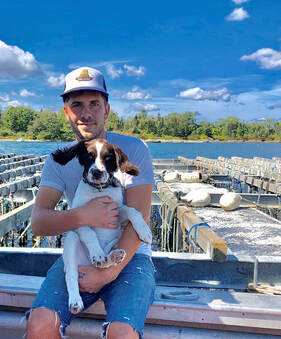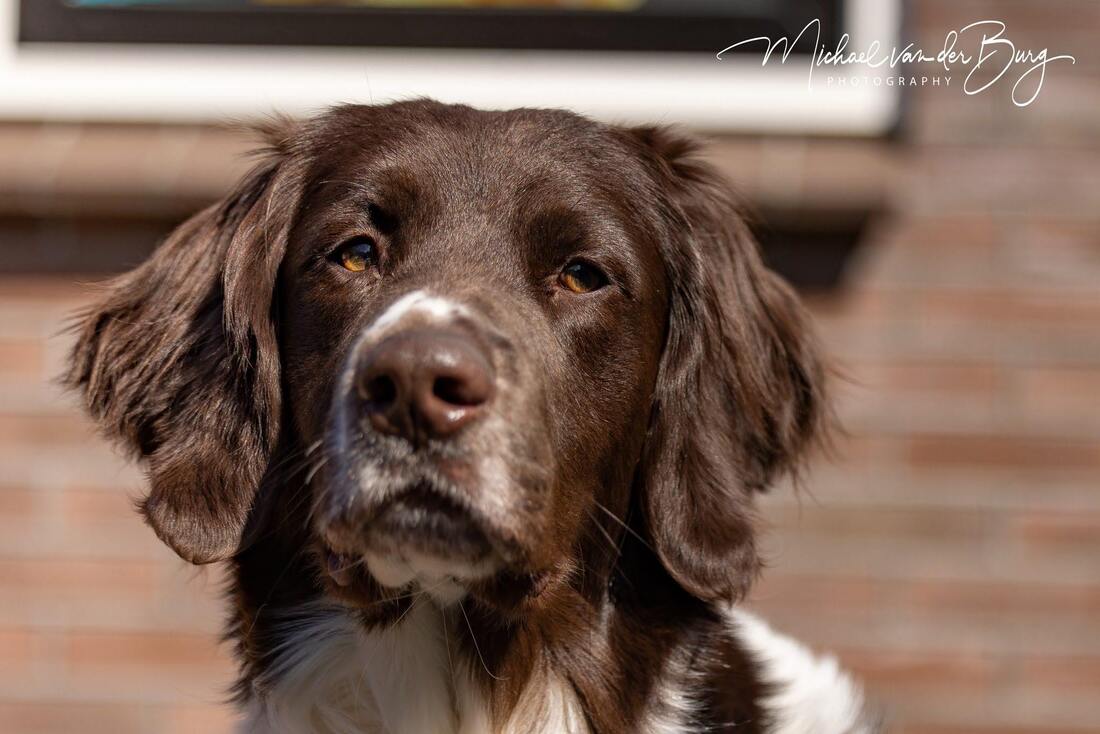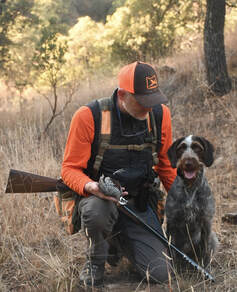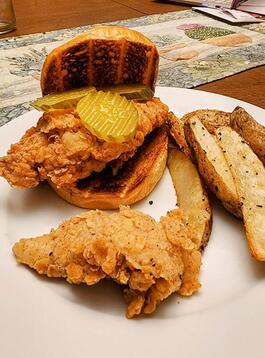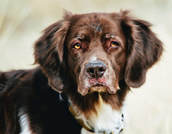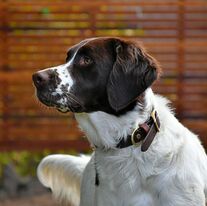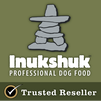 Jenna and I would like to take a quick moment to tell you a little bit about the American Drentsche Patrijshond Association. Despite our previous relationship with the other domestic Drent organization, we stopped being heard, or valued some time ago. Now we no longer feel represented by their mission, vision, or conduct. We aren't alone. The ADPA was envisioned by some Drent enthusiasts who thought things could be better and in short order all active Drent breeders, and those seeking to breed in the near future, came together and left the other organization to found the ADPA. The ADPA is about building a supportive community of Drentsche Patrijshond fanciers who wish to celebrate, promote, preserve, and advance the breed through education and mentorship, continuous improvement of thoughtful breeding practices, and enjoyable community events and exhibitions. The ADPA is recognized by the American Kennel Club, and is a legal non-profit entity. If you are interested in joining a breed Association that is interested in working together to create synergy and community, or even if you just want a place to share your silly Drent photos and stories, then look no further than the APDA! Friends of the ADPA (FaceBook) AmericanDrentAssociation (Instagram) AmericanDrentAssociation (FaceBook Official) The ADPA is currently accepting applications for charter memberships (help us ensure the organization is set up for success and get a super cool limited edition t-shirt) as well as regular annual single and family memberships! As always, if you have questions, comments, feedback, or would like to chat - we are here, please just reach out.
0 Comments
With that all being said, what does it mean to you having a puppy or dog with a limited Registration? If you have no intent to show your dog in an AKC show ring or breed him/her, then it means very little as all performance events are open to you and there isn’t a negative impact with non-conformation AKC events, NAVHDA, IABCA or UKC participation.
What if you decide you would like to start participating in Open Shows and your puppy went home on a Limited? A Limited registration can always be changed to full later on if you decided you wanted to try the Open Show thing. You have to initiate the paperwork with us and the AKC will charge you what amounts to a nuance fee to make the change (currently $25). The only difference with limited is that you cannot show in open shows and puppies can't be registered out of the dog, but you still get the pedigree, registration number and all official documentation from the AKC. You can participate in every AKC non-conformation venue. What if you would like show and/or potentially breed and want those options open? Well that is between you and your breeder (us). For those wanting to show, there is a very easy solution -- we enter into a co-own arrangement with you. Co-ownership with us means that one of us goes on the AKC paperwork along with you. As far as the AKC goes, the only venue in which full registration is required is to enter Open Shows and win Certificate of Merit points. As mentioned, you can do AKC hunt tests and all the other titling sports without full registration. So for this, it allows our clients that want to show to have the ability to do so, while allowing us to manage rights regarding reproduction/breeding, to include mentoring when it comes time to find a partner for your dog. If breeding (or providing stud service) becomes something you would like to explore, we want to ensure the dog is what we hoped & expected, that the basic health testing has been accomplished (is passing) as well as hunt testing, and show ring exposure in particular if/when breeding (made available for stud) becomes something you would like to pursue. To help us with evaluation, with co-owns, we have a higher expectation of getting regular photos of the dog as it matures. Ultimately, there is no downside. For us, co-ownership doesn't involve any of your day to day with the dog. It only provides a method of having some say over what gets bred. We hope that all makes sense! The breed standard of the Drentsche Patrijshond doesn’t state it outright, but the Drent is a “head breed”.
So, what does that mean, being a “head breed”? The details of the head are what defines a Drent. It is these details individually, and in summary that separates the Drent from the German Longhaired Pointer, Small Munsterlander, French Spaniel, or other somewhat similar white and brown piebald continental hunting dog from western Europe. Another element not mentioned in the breed standard that all true fanciers can and will go on and on about is the “expression of the Drent”. The expression of the Drent is the summary of all the details of the breed standard referencing the head; eye set, shape and color, ear set, muzzle length and proportion to skull, stop, nose bridge, and so forth all coming together in balance to create the classic look of the Drent; calm, warm, inviting and intelligent. A correct expression is defining of the Drentsche Patrijshond, much in the way that correct coat defines a German Wirehaired Pointer. Once you know what the correct expression of a Drent is, you cannot unsee it. Here is Bono Cooper v. d. Bezelhonk for reference.
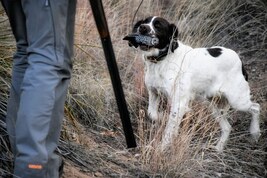 I learned that temperatures in the low 100’s for over a month straight caused any early season chicks to perish from exposure, since they would have been incapable of regulating their body temperature. Additionally, due to the high heat, hens will not lay eggs. Then there was the “heat dome” itself, which caused the vast majority of the much-needed monsoon storms to skirt around the areas most needing them to create food and cover. Then there is this other massive complication, the ranchers and the Forest Service itself. 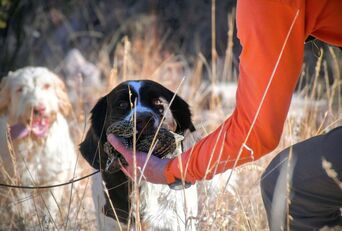 The winter rains of ‘22/’23 created a bumper crop of prairie grasses. It was incredible! So the ranchers brought in record numbers of cattle to eat all of this grass. In sixteen seasons of hunting the same region, I honestly can’t think of a time where I saw so many cattle. Then the heat dome sat in, and warded off the summer rains, aka monsoons. With that grass production halted and the huge herds acted like cancer of the prairie and consumed tens of thousands of acres of Forest Service land down to rocks and dirt. Many areas simply looked as if a bomb had gone off. The cattle were even eating young mesquite shoots, and old yucca leaves. It was surreal. Ranchers aren’t always the stewards of the land that they oft claim they are, and the U.S. Forest Service gets and F- for their management efforts. 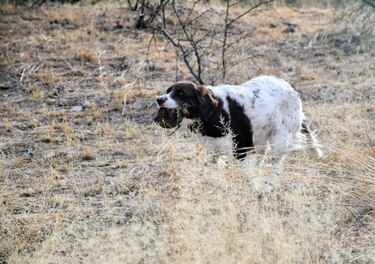 As you might imagine, it all made for a tough year for the quail. With ground cover either being non-existent or in fairly rough shape, the Mearns, famous for holding tight, were acting a lot like desert birds and running like track stars. It was hot, mid-70’s, no cloud cover, and no air movement. Basically, it was tough, but there were birds. Some areas coveys weren’t healthy, maybe two or three birds – no shooting, and we never went back. In other areas, coveys were healthy, the typical six to eight birds and in select places there were large coveys, twelve or more birds. The trick was to find places where the rain managed to sneak in, where the terrain and cover created cooler micro-climates where the birds could thrive. 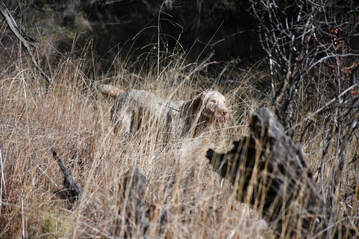 With all that being said, was it really that bad? Well sort of, but also not at all. Thankfully word got out, and the army of hunters who normally find their way to the region flagged off and went elsewhere. So, hunting pressure overall was much lighter, basically COVID levels. Still people figured out some of the bigger easier to get to areas and turned the screws, sadly decimating the quail populations that were there… We continued to explore new to us areas… We certainly found our share of birds and Ila turned out to be the hero of the trip. Despite tough conditions, she managed to come through over and over for us. Everyone else did well, and even little Rye started to figure out how to work in the hot, dry conditions.  In fact, the dogs did such good work overall, I had several days my shooting (hitting) was 100%! I don’t know that I’ve ever had a day of quail hunting where I hit everything, I shot at let alone several of such days! When the dog has the birds dead to rights, and you have the opportunity to walk up slowly and calmly, consider your shooting lanes, or on many cases, windows. Release the dog for the flush and pick your bird(s) in a quiet Zen state, wow, just wow. Of course, I had a few days I didn’t do so well, but that is rough shooting for you, and Mearns quail hunting is oftentimes some very rough shooting! All in all, we had a solid season, and made a few new friends. We can only hope the monsoons are good this coming summer, the ranchers scale their operations accordingly, and that the Forest Service does their job to protect the land. 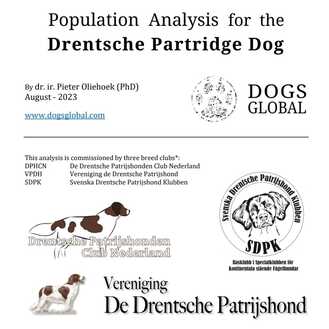 We are proud and excited to share with you Dr. Pieter Oliehoek's report on the Genetic Diversity of the Drentsche Patrijshond. The report was commissioned by three European Drent clubs (VDPH, DPHCN, and SDPK). Dr. Pieter Oliehoek manages Dogs Global and is recognized as a leading expert in genetic management of rare breeds, is now available to the public. Since my retirement from the Air Force in 2018, I dedicated myself to researching population management from the prospective of Zookeepers who manage breeding programs of endangered species kept in captivity, and to a lesser extent herd management practices of ranchers. Surprisingly, there are very few differences in approach - meaning many common threads abound! Here is what is really exciting about the report; first and foremost you do not need to be a scientist to read, process and understand the report. It was originally written in English and uses plain language. Two the concepts are not rocket science, perhaps, rather surprisingly common sense, and really don't require any "gymnastics" to execute. The report discusses all major challenges and the simple measures that would bring balance to each situation. In fact the report simply codifies what Jenna and I have been doing with our breeding programs and working towards achieving since we began collaborating on breeding Drents back in 2013!
Ingredients 1 Pheasant or Ruffed Grouse breast (chicken could be substituted) Marinade/brine 1 cup Buttermilk ¼ cup Pickle Juice 1 Egg 1 Tbsp. garlic powder Dredge 1-1/2cups Flour ¼ cup Cornstarch 1 Tbsp powdered sugar ½ Tbsp baking powder ½ Tbsp course ground black pepper 3 tsp mustard powder 2 tsp Smoked Paprika 2 tsp Onion Powder 2 tsp garlic powder 1 tsp Salt 1 tsp MSG Sprinkle of Cayenne Powder Other Peanut or other high smoke point frying oil Serve with Brioche Bun Mayo, Mustard, Honey Sauce Sliced Pickles Method Carefully remove the tenderloin and gently pound out breast fillet to a mostly uniform thickness, approx. ¼”. If you are using chicken, slice breast in half into roughly bun size pieces. Now using that knife thin out, butterfly the upper portion of the breast so it’s a little thinner which will promote even cooking. Optional, lightly score fillets on one side, this helps the brine, and give you more surface area for the Krispy. To a bowl, add milk, egg, and pickle juice and whisk together. Carefully pour your marinade/brine into a 1-gallon zip lock bag. Toss meat in, seal, shake gently. Carefully remove air from bag and let rest in the refrigerator for 45 minutes to several hours. (note: this could be brined overnight if you would like). Get your fryer ready and use as directed or fill a pot or wok with 2 inches of peanut oil and place over medium heat. Slowly bring to 350 F while we prepare the chicken. For the dredge, add flour, cornstarch, smoked paprika, and seasonings into a shallow open container. Whisk together thoroughly. Once you are ready to fry, splash some of the milk brine into the flour to create little clumps which will stick to the chicken breading. Take the breasts out of the brine and gently add to the dredge. Sprinkle some brine on the top surface and carefully cover with the dredge and gently press. You can repeat this sprinkle and cover an additional time if you are careful. Make sure to coat them thoroughly and press the dredge onto the exterior so it sticks. Allow to rest a few minutes. Verify the oil has reached 350 F, then gently place the pheasant into the oil and let fry for ~5 minutes until golden brown and delicious. Carefully turn the meat pieces around in the oil as they fry so the oil doesn't have any cold spots and the meat cooks evenly. Take your Krispy fillet out of the oil when it reaches an internal temp of 155 degrees. Add a sprinkle of salt. Toast your brioche. To serve, place your honey, mayo, and mustard sauce on a bun along with some pickles. Place the chicken breast on the bun, and you are ready to dig in. 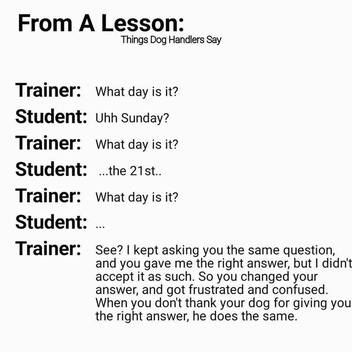 When I talk to handlers about what their e-collar stim means to their dog. I get the most interesting looks. Then I ask, so when your dog does X (undesired behavior) what are you going to do? The handler usually states, "light it up" or something along those lines. But why, I mean, does the dog know what being "lit up" means? Again, usually more puzzling looks. Using the e-collar like an electric "no" is just as ineffective as saying "no" to a dog. What is more effective then, you may be thinking? Well, instead of "no" try having your dog do something it has been taught e.g. "off, down, leave it, sit, or even here/come". Basically, give the dog something to do, more importantly something the dog knows how to do, and does well. We use the e-collar for a silent recall, a non-punitive, low-level stim cue to recall. A cue that quickly becomes fun and rewarding to the dog, which they are more than happy to abide with. So, a "gentile tap" = recall and nothing else. This recall can be used to curb all manner of behavior to the extent that the dog gives its intent away when it does something that has been worked on, and automatically gives itself a recall. I'm not saying what we do is perfect, but our dogs know what a stim means, and that having a bulletproof recall can not only curb a range unwanted behavior, but also can save a dog's life 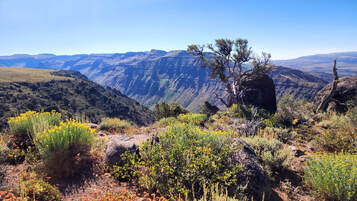 Yes, you read that right. There are easier and far more typical places to hunt Sage Grouse, but when Dominic Bachman invites you to go hunting with him, you clear out your calendar to make it happen. Even more so when the hunt is in such a unique and challenging environment. This distinctive southeastern Oregon hunt must be applied for in advance, then if you are lucky enough to be chosen for this intense event, with less than a 10% chance of being drawn, you have to be prepared for high elevation. All the best hunting is right around 8,000 feet of elevation. The breath-taking views encompass Hawaiian-like canyons, dramatic mountain peaks, desert oasis’ and alpine lakes – all in one spot! The hunting itself is incredibly challenging, even more so for me since I battled intense bouts of sciatica the entire time. The sage brush is low, compact and incredibly dense which makes walking nearly impossible. Each step is literally more akin to a high step march, with the footing of each step being questionable. This was hard and I wanted to quit, badly. But I was there. I signed up for this adventure for this experience. So, I did my best to put my big boy pants on and see it through. 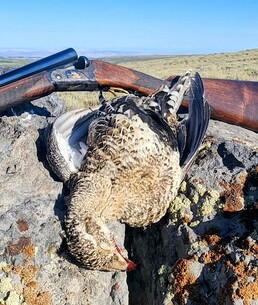 1st Grouse in the bag with my 20 ga. FAIR 1st Grouse in the bag with my 20 ga. FAIR I brought Ila, Fizzy and Rye along for this adventure. Up before dawn and rolling in the dark to a new location can be a surreal experience; follow the leader. With the sun beginning to light the horizon on fire, I took solace in having downloaded a lot of extra maps in my OnX. We arrived and Dom said, “This is your oyster”. A large roughly triangular shaped piece of mountain slope with a few rocky knobs. We Jimmy Jammed from the bottom to the top – straight into the sun. With sciatica firing off with nearly every step, and in some cases shorting muscles out robbing me of what little power I have. Good times. For this first hunt I had Rye and Fizzy down, once at the top, we began to roughly zigzag the rest of our “field” back down and roughly into the wind. It became clear that bird numbers where not what Dom had anticipated. I kept waiting to hear a shot in the distance… because we had nothing. No sign at all. This hunt got long, my legs a tad wobbly, and mentally I was starting to check out. I began to wheel around to the left to make what would be one of the last zigs to be made. Within a few steps, the girls began to come around. BAM. Rye froze, Fizzy froze. I completed my step, and a grouse few wild! I took a passing shot and wiffed but had the presence of mind to look back to exactly where it came from, as it was highly likely there would be more. On cue, a second bird few, and with a little more zen I took and made the shot! We were on the board. We hunted later that day, still with no success for the party.
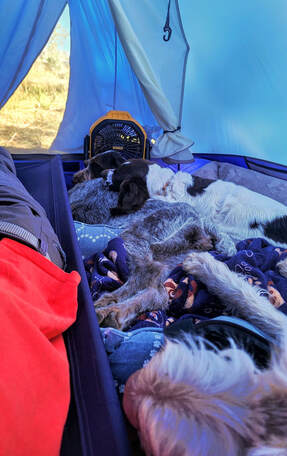 Never underestimate the value of a nap with friends Never underestimate the value of a nap with friends We got the spare on, then took Dom’s truck to do some exploring and decided to hunt the hilltop above where he and Aaron had collected three birds earlier in the morning. I had Ila down, as I really wanted her to have a successful Sage Grouse hunt. As we were coming to terms with the hunt turning into a walk with dogs whilst carrying firearms a single grouse flew wild from Dom’s right. Once the grouse had cleared the dogs, he dispatched the bird with a cool dispassionate efficiency. He was done, which was good for him, as he needed to pack up and go home…he had to work in the morning. We had a good laugh over Aaron’s misfortune the morning before. Their hunt took them basically up to my tuck, where they had seen a few grouse land near. They had dropped off some of their surplus gear in my truck, and while they were farting around, Aaron had discovered an interesting perfectly heart shaped rock. He stepped on it and it gave more than he had anticipated, which prompted him to turn in over. This is when he learned I had used said rock to cover my morning expurgation. He was, mortified. This gave Dom and I a hell of a good laugh. Day two ended with a beautiful, but unproductive hike where I ran all three girls in a Hail Mary attempt to pick something up. 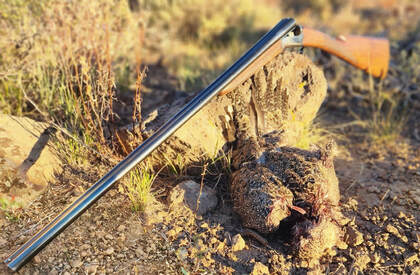 2nd grouse, taken with my 28 ga FAIR 2nd grouse, taken with my 28 ga FAIR I was prepared to leave early to get to Burns to have the truck checked out, after all the steering wheel was rocked nearly a full 90-degrees out of whack. Not an exciting prospect when facing an eight-hour drive home. Jenna and I chatted, and she convinced me to go ahead with the plan to do the short hunt close to camp, if for anything just for the girls to stretch their legs – tomorrow was going to be a long day in the truck for them, in particular if I had to wait to be seen at the Les Schawb there in Burns. The only place in a zillion miles that could be of any help to me. We set out, and about 30 minutes in I was about to turn back to the tuck to wrap this encounter up and there it was. A single grouse turd. Really. One single grouse turd, old and dried up. All alone. I laughed to myself. Only I would find a single grouse turd. Within a few steps an old roost. Hey, not bad I thought to myself. Then another ten feet, another roost, then another, and another. My hopes began to rise. This had been the most sign I had seen in all the hunting I had done thus far. But where were they? Up to my left a single snowberry bush stood proudly above the sage like a sore thumb. As Fizzy approached it, a single grouse flew wild, and it bombed down and into the ravine to my right. No way for any shooting there, and really there was no way I was going down after it. My brain clicked on, go to the bush! As I did Ila and Rye came around and became birdy. Rye hung around the snowberry, Ila went into tracking mode, head down, tail swishing. She was on ground scent. They were running! A bird flushed wild well out ahead of her. I shot; the bird was down! I was finished. I had done it. I had made it through the difficulties, it was a great feeling to have. Would I do it again if given the opportunity to do so again, yes, of course. It was an incredible trip, thanks for inviting me Dom! |
Categories
All
Our YouTube Content
Two GunI'm just a guy suffering with an infatuation with gundogs since childhood. Forty some years later this is what you get. Archives
July 2024
|
|
|

